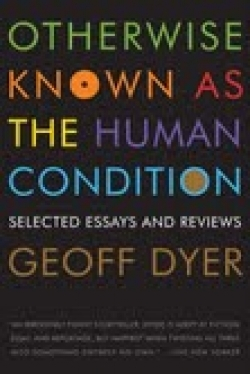Otherwise Known as the Human Condition
Selected Essays and Reviews
A title like Otherwise Known as the Human Condition sets expectations of broad strokes: one imagines an encyclopedic knowledge of humanity. To his immense credit, Dyer delivers such breadth in a series of analyses of cultural phenomena—the blues, the non-place, Avedon’s photography, and the ghost bike, to name a few.
This, his third essay collection, brings into a single (though hefty) volume a selection from two previous works. The pieces were first released in publications such as Vogue, The Guardian, Esquire, and American Scholar over a twenty-five-year period. To unite essays from this variety of sources in one binding, Dyer employs topical categories to name the book’s five sections, beginning with “visuals” (photographs), “verbals” (literature), and “musicals.” His two final sections, “variables” and “personals,” are looser in terms of focus than the previous three, but the book remains centered on artifacts that arrest Dyer’s keen mind.
Dyer at once resists and embraces this topical organization. For him, an “unruly range” of concerns measures his success as a writer. He describes his writing career as unfettered by specialization or allegiance to any one genre—having written novels, travel books, and critical studies. Yet his essays seem unitary as they circle around a single, large archive, which includes Susan Sontag, John Berger, and others. (The essay on Dyer’s “reader’s block” may indicate that this archive is more closed than one is led to believe.)
While Roland Barthes and Raymond Williams are among those who have served as models for Dyer’s own professional identity, don’t expect high theory from this book. Rather, Dyer’s essays are accessible and not directed toward an expert audience; indeed, the writer explicitly positions himself outside of the academy (see “Def Leppard and the Anthropology of Supermodernity” or the title essay, which focuses on Doughnut Plant doughnuts). Although Dyer sees himself as a modern embodiment of the traditional man of letters, this book is unlikely to be a forerunner for a new school of thought.
As much as it is a work of cultural criticism, this is an autobiographical book. With each essay, one learns more about that much-sought “non-career” (to use Dyer’s words)—writing. The introduction trains readers to keep Dyer-as-writer in full view. And Dyer reveals more about writing when he’s not aiming to do so. One has to distrust claims like “I have always written without any regard for the presumed audience of a given publication” given that several of his pieces were commissioned. Even still, the book remains a valuable illustration of what a contemporary critic’s vocation can comprise—filled as it is with humor, sophistication, and the hard-to-reach detail.
Reviewed by
Janelle Adsit
Disclosure: This article is not an endorsement, but a review. The publisher of this book provided free copies of the book to have their book reviewed by a professional reviewer. No fee was paid by the publisher for this review. Foreword Reviews only recommends books that we love. Foreword Magazine, Inc. is disclosing this in accordance with the Federal Trade Commission’s 16 CFR, Part 255.

